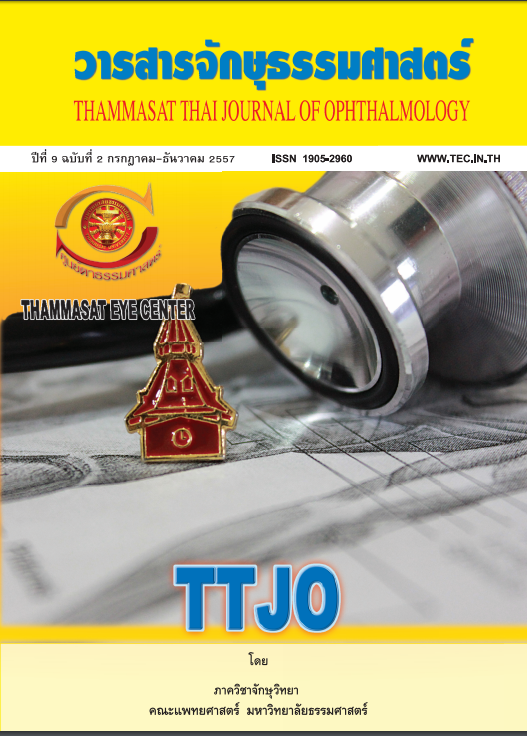การเปรียบเทียบประสิทธิภาพของการตรวจคัดกรองภาวะเบาหวาน ขึ้นจอตาจากการถ่ายภาพจอตาดิจิทัลโดยแพทย์ทั่วไป และการใช้กล้องจักษุจุลทรรศน์โดยจักษุแพทย์
Main Article Content
Abstract
วัตถุประสงค์: เพื่อศึกษาประสิทธิภาพการตรวจคัดกรอง ภาวะเบาหวานขึ้นจอตาด้วยการถ่ายภาพจอตาดิจิทัลโดย แพทย์ทั่วไปเปรียบเทียบกับการตรวจภาวะเบาหวานขึ้น จอตาด้วยกล้องจักษุจุลทรรศน์โดยจักษุแพทย์
รูปแบบการวิจัย: เป็นการศึกษาแบบ Prospective, comparative, instrumental validation study
วิธีการวิจัย: ศึกษาโดยคัดเลือกผู้ป่วยเบาหวานชนิดที่ 1 และ 2 จำนวน 62 คน อายุระหว่าง 20-80 ปี ที่ยังไม่เคย ได้รับการวินิจฉัยว่าเป็นภาวะเบาหวานขึ้นจอตา ผู้ป่วย จะได้รับการถ่ายภาพจอตาโดยไม่ขยายม่านตาด้วยกล้อง ถ่ายภาพจอตาดิจิทัล รูปภาพทั้งหมดจะได้รับการอ่าน และแปลผลผ่านจอคอมพิวเตอร์โดยแพทย์ทั่วไป แล้ว รายงานผลว่า พบจุดเลือดออก จุดรั่วซึมจากเส้นเลือด จุดขาดเลือด ภาวะเส้นเลือดผิดปกติ ภาวะเส้นเลือด งอกใหม่ ภาวะพังผืดที่เกิดขึ้น และจำแนกความรุนแรง ของภาวะเบาหวานขึ้นจอตาตามหลักเกณฑ์ของ Early Treatment of Diabetic Retinopathy Study (ETDRS) รวมทั้งรายงานว่ามีการบวมที่จุดรับภาพหรือไม่ หลังจากนั้น ผู้ป่วยจะได้รับการขยายม่านตาด้วย 1% Mydriacyl 1 หยด ทุก 5 นาทีทั้งสองข้าง และรับการตรวจด้วยการใช้ กล้องจักษุจุลทรรศน์โดยจักษุแพทย์ รายงานผลตาม
หลักเกณฑ์ลักษณะเดียวกัน หลังจากนั้นนำผลการ วินิจฉัยด้วยการถ่ายภาพจอตาดิจิทัลโดยแพทย์ทั่วไป และจากการใช้กล้องจักษุจุลทรรศน์โดยจักษุแพทย์มา เปรียบเทียบกัน
ผลการวิจัย: ค่าความไวของการตรวจผู้ป่วยด้วยการ ถ่ายภาพจอตาดิจิทัลโดยไม่ขยายม่านตาและอ่านผลโดย แพทย์ทั่วไปในการวินิจฉัยเบาหวานขึ้นจอตา คือ 80.95% ค่าความเฉพาะของการตรวจผู้ป่วยด้วยการถ่ายภาพจอตา ดิจิทัลโดยไม่ขยายม่านตาในการวินิจฉัยเบาหวานขึ้นจอ ตา คือ 97.56% ความน่าจะเป็นที่ผู้ป่วยจะมีเบาหวาน ขึ้นจอตาจริงเมื่อตรวจด้วยการถ่ายภาพจอตาดิจิทัลโดย ไม่ขยายม่านตา คือ 94.44% ความน่าจะเป็นที่ผู้ป่วยจะ ไม่มีเบาหวานขึ้นจอตาจริงเมื่อตรวจด้วยการถ่ายภาพ จอตาดิจิทัลโดยไม่ขยายม่านตา คือ 90.91% ความชุก ของเบาหวานขึ้นจอตา 33.87% ค่า Weighted Kappa เท่ากับ 0.898 Standard error เท่ากับ 0.0428 โดยมี 95% Confidence interval เท่ากับ 0.814-0.982
สรุป: การถ่ายภาพจอตาดิจิทัลโดยไม่ขยายม่านตาและ อ่านผลโดยแพทย์ทั่วไปที่ถูกฝึกมาเพื่อวินิจฉัยเบาหวาน ขึ้นจอตามีประสิทธิภาพในการวินิจฉัยเบาหวานขึ้น จอตาได้ใกล้เคียงกับการตรวจด้วยการใช้กล้องจักษุ จุลทรรศน์โดยจักษุแพทย์ได้ แต่ยังมีความจำเป็นต้อง
ใช้กล้องถ่ายจอตาดิจิทัลที่มีความละเอียดสูง จอที่ใช้ดู ในการแปลผลต้องมีความคมชัด และแพทย์ทั่วไปต้อง ได้รับการฝึกอ่านภาพและแปลผลภาวะเบาหวานขึ้น จอตาเป็นอย่างดี
The Efficiency Comparative Evaluation of Digital Fundus Photography by General Practitioners versus Slit-lamp Biomicroscopy by Ophthalmologists in Screening for Diabetic Retinopathy
Objective: To compare the efficiencies of diabetic retinopathy screening using digital fundus photography by general practitioners versus dilated fundus examination using slit-lamp biomicroscopy by ophthalmologists.
Design: Prospective, comparative, instrumental validation study.
Participants: Sixty-two diabetes mellitus patients aged 20-80 years with no history of diabetic retinopathy were included.
Methods: The fundus photographs through non-dilated pupils were taken using the digital fundus camera, evaluated by general practitioners, and graded for diabetic retinopathy according to the Early Treatment of Diabetic Retinopathy Study (ETDRS) including the presence or absence of macular edema. The pupils were dilated using 1% Mydriacyl every 5 minutes for 6 times. Ophthalmologists then performed comprehensive fundoscopic examination using the slit-lamp biomicroscopy.
Results: Two methods were assessed for comparative agreement. Sensitivity, specificity, positive and negative
predictive value of the digital fundus photography for diabetic retinopathy screening by general practitioners were 80.95%, 97.56%, 94.44% and 90.91%, respectively. Prevalence of diabetic retinopathy was 33.87%. The weighted kappa was 0.898. Standard error and 95% Confidence interval were 0.0428 and 0.814 – 0.982.
Conclusion: This study suggested that the screening efficiency of using nonmydriatic digital fundus photography by general practitioners was comparable to the dilated fundus examination by ophthalmologists. Both methods can be used for diabetic retinopathy screening. However, the fundus photographs must be high quality, and the general practitioners must be well-trained.


